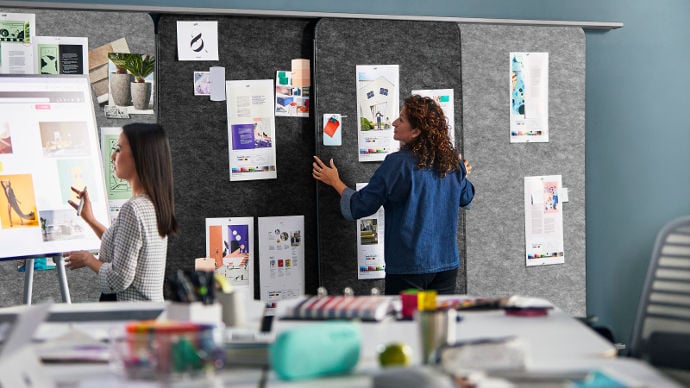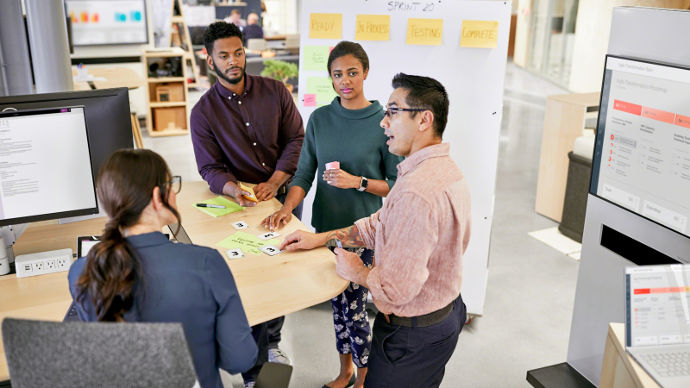In today’s organisations, not all work is done in stable teams. Teams are more often formed on a project by project basis, where people from multiple departments with different skills come together to work towards a specific goal.
This is what Amy Edmondson, author and professor at Harvard Business School, calls teaming.
What is teaming?
“Teaming is teamwork on the fly. It involves coordinating and collaborating without the benefit of stable team structures, because many operations... require a level of staffing flexibility that makes stable team composition rare.” Amy Edmondson, in her book Teaming: How Organizations Learn, Innovate, and Compete in the Knowledge Economy
The big difference between teaming and teams is that teams are stable, static groups of individuals who have had time to get to know each other's unique strengths, weaknesses and skills and found ways of working together successfully.
Teaming is recognising that when strangers come together in teams, they haven’t had this time interacting and getting to know each other.
As Amy explains, the challenge is this:
“How do you create synergy when you lack the advantages offered by the frequent drilling and practice sessions of static performance teams like those in sports and music?”
How do we help these teams to people who don’t know each other well, to collaborate and innovate as a group?
Office design tips for better collaboration
Teaming is becoming a feature of more and more people's working lives.
And just as workplace design trends have evolved so workers can thoroughly engage with agile working, so too can we can transform the layout and design of the workplace to support teaming.
Here are 8 office design tips to support better collaboration in teaming.
1. A place to call home
Teams need to work in close proximity and somewhere they can surround themselves in their project and display their thinking and ideas. This should be a dedicated workspace they can return to each day throughout the duration of the project. It helps team members sustain a shared mindset, allows them to focus, and speeds up the collaborative process.
Gale Moutrey, Vice President, Workplace Innovation + Brand Communications at Steelcase explains:
“If you’re really into a project and you leave at night, and then the next day immediately walk back into your ideas, I think that’s one way we can ignite people’s passion for the project from day-to-day.”
What these on the fly teams need is a flexible workspace where they can set up home for the duration of the project. These spaces may include a range of furniture to suit both collaboration and individual focus work, allowing team members to quickly switch between the two.
7.jpg?width=690&name=13-0003591%20(2)7.jpg)
2. A hackable space
“Teams need a home where they can surround themselves in their project and display their thinking and ideas. They need to be able to quickly switch between collaboration and focused work. And they need control to rearrange their space at any time, on their own.” Steelcase
Teams need a dynamic space that keeps up with their process and keeps them in flow. A space they can reconfigure on their own to suit work flows and changes throughout the project. But most spaces are designed with fixed furniture and walls that can’t adapt easily or quickly to the changing activities required throughout the project.
Regardless of whether a team is working together for the first time or not, they should have the freedom to adapt, or ‘hack’, the workspace in the way that they want. Being able to move furniture and materials around so they can physically engage with their content, change postures and gain new perspectives, helps teams to get the most out of the space.

3. Moveable furniture
In order to adapt the space to increase collaboration, furniture and accessories need to be moveable. It's not just chairs that can be moved around; wheels can be added to boards, desks, storage facilities so teams can quite literally (and physically) create a space that works for them.
%20(1)1.jpg?width=690&name=19-0116891%20(1)%20(1)1.jpg)
4. Furniture that encourages movement
Furniture that encourages movement can support active collaboration. Research suggests that when people take up standing positions they are more energised and more engaged with their work and with each other.
Furniture such as stools and high tables encourage perching or standing, which helps create synergy and a buzz within the team that brings them closer together, sharpens their focus, and unleashes creativity.
1.jpg?width=690&name=19-0122696%20(1)1.jpg)
5. Easy access to tools
Effective collaboration within teams involves knowledge sharing, brainstorming and scenario building. Tools like whiteboards, sticky notes, and a place to tack them, are all helpful for recording ideas and helping teams reach a shared understanding.
“I’ve been into office environments where people are gathered around writing ideas on the windows because they haven’t been given the tools they need.” Gale Moutrey, Vice President, Workplace + Brand Communications, Steelcase

6. Technology integration
Teams need access to technology for group work, and integrating modern technologies into the workplace helps to create an environment for active collaboration. But the design of the space needs to be carefully considered so everyone can access and engage with content on the screen.
When collaborating with team members across sites, conferencing technology should be placed carefully to ensure all users are on camera and clearly audible. Multiple screens can be included so participants can see each other and their content at the same time, making sure people can move and stay on-camera without disrupting the flow of interaction.
The space should also allow teams to quickly switch between digital and analog tools for thinking and collaboration. For example, screens that can be moved around within the space allow for digital technology to be brought to the forefront when required and hidden away when not.
5.jpg?width=690&name=18-0110837%20(1)5.jpg)
7. The 'me' within 'we'
“Forget the old adage that ‘there is no ‘I’ in team. Teams are made up of individuals. We need to design for multidisciplinary teamwork in a way that also gives the individual what they need to do their best work.” Gale Moutrey, Vice President, Workplace + Brand Communications, Steelcase
The best workplaces don’t only support the activities of the team, but also nurture the needs of the individuals within the team. The best team spaces are designed for what the team needs to do together, whilst simultaneously recognising the ‘me’ within ‘we’. This can mean the inclusion of workstations where people can do focused work while still being in close proximity to the rest of the team.
Collaborative workers also require spaces for individual focus and rejuvenation. Workplaces that include calmer, contemplative spaces provide a haven for workers to relax and destress, so that they can come back to the team refuelled and better able to collaborate and innovate. These spaces could include pods, booths or larger no-tech zones, fitted with furniture that aids lounging and relaxation.
8. Design to inspire
The look and feel of the workspace also has an impact on the ability of your team to collaborate and be creative. The layout, design and ergonomics of the workspace affect how people feel, and people like working in spaces that make them feel good. With this in mind, more organisations are opting for lighter, brighter, creatively stimulating environments, as well as more natural materials and the addition of plant life into the workspace.
Summary
“Why should managers care about teaming? The answer is simple. Teaming is the engine of organizational learning. By now, everyone knows that organizations need to learn how to thrive in a world of continuous change.” Amy Edmondson
In a growing number of organisations, workers are continually having to respond to opportunities. And this constant shift in the nature of work means that teams are having to come together and disband almost as soon as they’ve formed.
The workplace environment can support these short-lived teams to collaborate successfully and effectively.
These teams need a base, a space where they can engage in idea generation and surround themselves with their work. Teams must be able to ‘hack’ this space to get the best out of it, by moving furniture, tools and technology around. And they need inspiring environments that support not just the team as a whole but the individual members.









